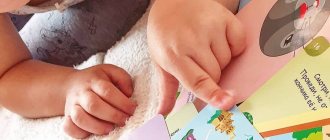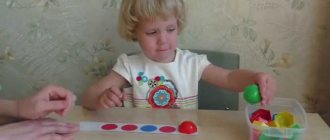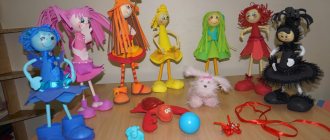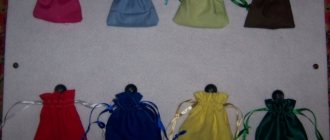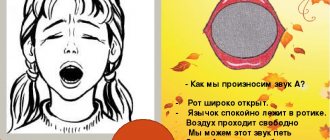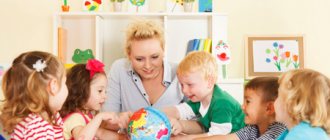What skills do older preschoolers need to develop?
5-6 year old children are very inquisitive. Reading fairy tales and stories with adults, learning to read, count and draw perfectly stimulates interest in understanding the world around us.
The main areas of study during this period:
- fine motor skills training;
- development of attention;
- development of logic;
- speech development;
- numeracy skills.
In this regard, it is possible to divide developmental activities for older preschoolers into the above groups.
Classes for children are conducted in the form of games.
Calm, entertaining tasks
It is advisable to alternate active competitions with calm competitions that require attention, intelligence and ingenuity. In small rooms they are easy to carry out so that children enjoy playing in them, they should be fun and include fun tasks.
Inside out
The presenter pronounces the words, the children arrange the letters in reverse order, write the resulting word, for example, having heard “pencil case”, the child writes “lanep”, the word table - “lot”. Use a variety of words appropriate to the age of the players.
New fairy tale
Children are invited to turn into good wizards to help the sad story. Choose any fairy tale with a sad ending, and then ask the children to come up with a happy ending. Prepare your props and act out the scene.
Speak without hesitation
Participants receive a piece of paper with a picture, and the child who reads it the fastest wins.
Drawing blindly
Two teams participate, the players must draw a car blindly, the children take turns blindfolded and asked to draw one part of the car.
The one who is more like the real one wins.
Guess the song
This is a competition in which groups of children are given cards depicting various objects, animals, plants and things from famous songs.
Teams must guess which songs are encrypted in the pictures, the drawn train can mean the song “Blue Car”, the red-haired boy can mean the song “Red, Red, in a Mask”, the image of a mammoth can mean “Song about the Mammoth”. Caring parents can always make their children's holidays interesting if they take a creative approach to organizing it. A selection of fun games for children will help them with this!
Educational games for children 5 – 6 years old by goal groups
| Target | Game name |
| Fine motor skills training | 1. Stringing |
| 2. Coloring | |
| 3. Origami | |
| 4. Shadow theater | |
| 5. Sort out the cereal | |
| Development of attention | 1. What has changed? |
| 2. What to do? | |
| 3. Claps | |
| 4 Elements | |
| 5. Guess the toy | |
| Development of logical thinking | 1. Drawings from geometric shapes |
| 2. Endings | |
| 3. Fill in the circle | |
| 4. Good - bad | |
| 5. What happens? | |
| Speech development | 1. Complete the sentence |
| 2. Daily routine | |
| 3. Who eats this? | |
| 4. 3 words | |
| 5. What was what? | |
| Numeracy skills | 1. Where is the ball? |
| 2. Forward and backward counting | |
| 3. Feed the animal | |
| 4. Measurements | |
| 5. Cards with numbers |
Games to develop fine motor skills
Since the initial development of relevant skills has already been established at this age, the following games will help further improve fine motor skills in older preschoolers:
- Stringing. You can string beads, rings, buttons, pasta and other items. You will also need fishing line or strong thread. You can hold a “fair” where beads, bracelets and other jewelry made by the children will be presented.
- Coloring. The game is held in the form of a coloring master class or competition. Children are given pictures with outlines of shapes and explained how to hatch. Pictures need to be painted in straight and diagonal directions.
- Origami. Children are given paper and explained how to fold the figures. Then you can offer to organize a competition or play paper toy store.
- Shadow play. Turn off the lights in the room and point the light source at the screen (from a distance of approximately 4 m). Children are shown how to use hand movements between a light source and a screen to create pictures on the screen. You can act out scenes with shadow characters.
- We sort through the cereal. For this game you need to mix 2 types of cereals (for example, buckwheat and rice or millet) and ask the child to help sort the cereal into their jars. Subsequently, the task can be complicated by adding 1 or 2 more types of cereals.
Experts believe that the development of fine motor skills is directly related to the development of speech and intelligence in general.
E. O. Komarovsky
Pediatrician, Ph.D.
Working with your fingers affects the speech areas of the brain. It is necessary to begin developing fine motor skills from six months to 6 years. As a result, speech is formed correctly, memory and imagination are stimulated.
— E. O. Komarovsky Pediatrician, Ph.D.
Games to develop attention
The following games will help your child learn to acquire, accumulate and apply new knowledge:
- What changed? Up to 7 (but not less than 3) different toys are placed in front of the child. At a signal, the child closes his eyes, and the adult removes one of the toys. Then, again at a signal, the child must open his eyes and guess which toy is missing.
- What to do? Before the game starts, children are explained what action to perform when naming a particular word. Then the children walk in a circle, and the leader calls out any of the previously discussed words. In this case, players must perform a certain action (for example, “stork” - stand on one leg, “crawfish” - walk backwards, “hare” - jump, etc.).
- Claps. This is a game similar to the previous one. Only instead of a word, children must perform a certain action for a pre-agreed number of claps. So, for example, 1 clap can mean “stork”, 2 – “crayfish”, 3 – “hare”, etc.).
- Elements. Children sit in a circle. When the leader names a certain element, they must perform a pre-agreed action (for example, “water” - lower your arms, “fire” - raise, “air” - spread your arms to the sides, “earth” - cross your chest).
- Guess the toy. The child needs to depict some actions that would characterize the proposed toys (for example, show how a bear, a fox, etc. behaves).
Julia
In pedagogical activity, one of the main directions is the development of attention, since the quality of teaching will depend on it in the future.
- Julia
Games to develop logical thinking
Logical thinking skills are necessary as preparation for further education. The following games will help develop the ability to think logically:
- Drawing of geometric shapes. Children are given various geometric shapes drawn on a piece of paper. The guys must draw an object or character from the resulting geometric figure (for example, an apple from a ball, etc.).
- Endings. Children are asked to complete sentences like: “Masha left the house before Vera, which means Vera is ... (later Masha).”
- Fill in the circle. Children are given sheets of paper with 6 circles drawn several times and are asked to paint them in such a way that there are as many filled circles as unfilled ones. The one who offers the most shading options will win.
- Good bad. The child is asked to analyze any phenomenon from all sides, paying attention to positive and negative aspects, for example: “A lot of mosquitoes are bad, they bite, but it’s good that the birds have something to eat. There are no mosquitoes - it’s good, but the bad thing is that the birds have nothing to eat, they will fly to other places and there will be a lot of mosquitoes.”
- What happens? Children are encouraged to ask each other questions and take turns answering, for example: “What is white? (cloud, towel, etc.)” “What is big? (joy, car, mountain, etc.).”
Elena
Orenburg
A child’s logical thinking needs to be developed systematically and in a timely manner, so that in the future he can study well and achieve his goals.
— Elena Orenburg
Speech development games
Speech development is an important stage of learning; the following games will help with this, by the way, closely related to the previous group of logic lessons:
- End of sentence. Children are asked to complete the sentences based on the context (Vita didn’t come today because ... (sick); dad brought ice cream and put ... (in the refrigerator); Marina is going to the store to ... (buy groceries)).
- Daily regime. Children are shown pictures of different activities during the day. The children are asked to place them in the correct order.
- Who eats this? Pictures depicting various animals are given, and it is asked to determine which of them should be given, for example, grain, honey, apples, grass, etc.
- 3 words. Children are asked to name 3 words as an answer to one question, for example: “What can you cook? (egg, meat, pasta).”
- What was what? The presenter asks questions like: “Who used to be a chicken, a butterfly, a horse?”, “What used to be bread, a sweater, a table?”, and the children need to answer them.
A. N. Leontiev
Soviet psychologist, author of the general psychological theory of activity
Speech occupies a central place in mental development, the process of its development is development itself.
— A. N. Leontyev Soviet psychologist, author of the general psychological theory of activity
Preparatory group
In the preparatory group, preschoolers prepare for the transition to first grade and acquire important knowledge and skills. Therefore, complex didactic games with a predominantly educational focus are applicable.
Train for animals
To play, make a cardboard train with 3 carriages: the first for animals, the second for birds, the third for insects. Print out pictures depicting fauna representatives. The game task is to correctly arrange the pictures into the cars.
Man or nature
Children stand in a circle. Throw a ball to each of them in turn, asking at random, “What did the person do?” or “What has nature done?” In the first case, the answers will be, for example, “car”, “clothes”. And in the second there is “tree”, “river”, “stone”, “nest”. The player who finds it difficult to answer is eliminated from the circle. The winner is the last one to give the correct answer.
Name the plant
Say a sound and the players must remember the plants that start with it. For example: A – aster, watermelon, orange, pineapple, aloe, acacia, cherry plum.
Clouds
On a fine day, when cumulus clouds float in the sky, take the students for a walk. Let everyone choose a cloud and tell them what it reminds them of.
The benefits of rhythmic exercises for children
In addition to classes to prepare for literacy, reading and basic mathematical concepts, the preschool program provides for the development of musical and rhythmic abilities in children. For this purpose, many preschool educational institutions have included rhythm classes.
Experience shows that such activities in kindergarten and in the senior group not only bring joy to the child and amuse him, but also have many other positive factors. Among them are the following:
- They instill a love of dancing and music and develop musical taste.
- Thanks to them, shy children can relax, and active ones get good physical relaxation.
- All children begin to share concepts such as the style of music, its rhythm and tempo.
- Both the child’s physical fitness and coordination of movements improve significantly.
- Children have the opportunity to learn how to react adequately to any situation, control their state of mind and correctly express emotions.
All this led to the fact that great attention began to be paid to rhythm classes in the preschool education system.
Since mothers and fathers always want to know what their child is doing in kindergarten and what he is learning there, especially if the institution’s program includes classes that are not included in the compulsory preschool program, the kindergarten most often strives to conduct an open lesson on rhythm in the senior group simultaneously with parent meeting.
This is done so that it is possible to demonstrate to parents the skills and abilities acquired by their children, as well as the style of conducting lessons.
Games
You should practice every day, and in a week the first result will be visible: the baby’s attention, thinking, and memory will improve. During the games, he learns a lot of new things, and it turns out to be a kind of school.
To develop thinking
"Yes, no, yes"
Goal: learn to ask questions, develop listening skills and attentiveness.
How to play: the teacher thinks of a word, and the children must guess it using questions that can only be answered “yes” or “no.”
"Visual yes-no-ka"
Goal: learn to ask questions, develop listening skills and attentiveness.
How to play: the teacher lays out toys or pictures on the table. Then he makes a wish for a toy or a picture. The child’s task is to guess what the teacher has planned using questions that can only be answered “yes” or “no.”
